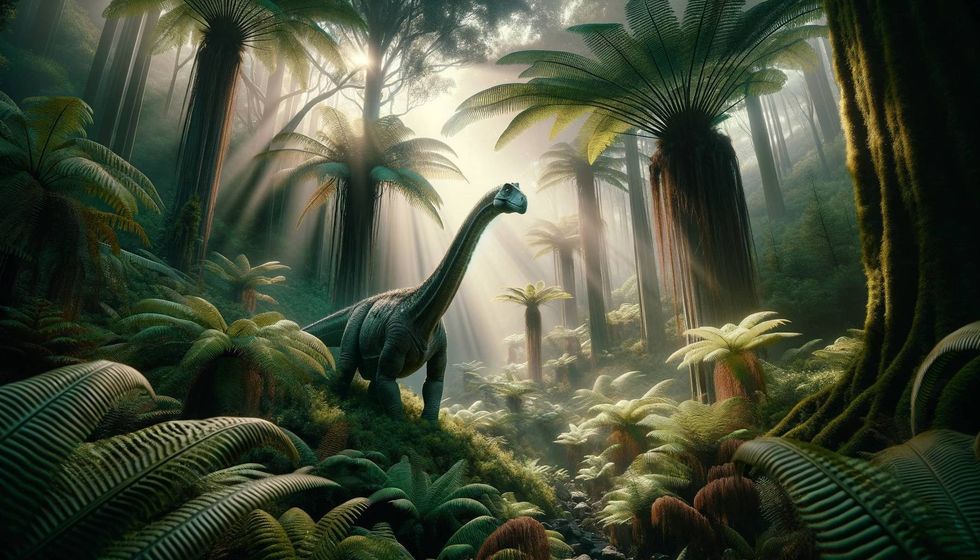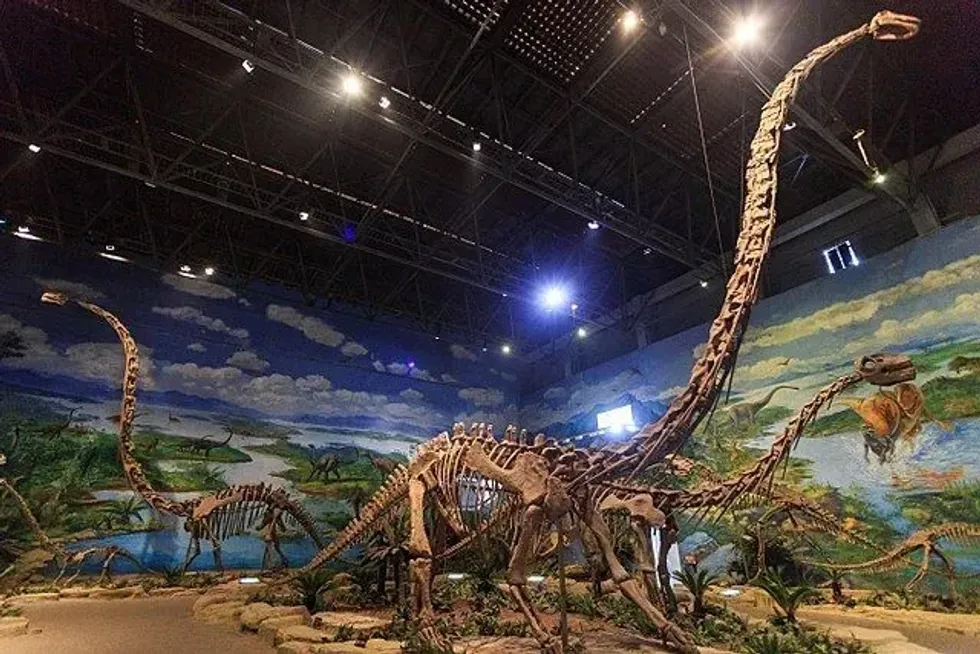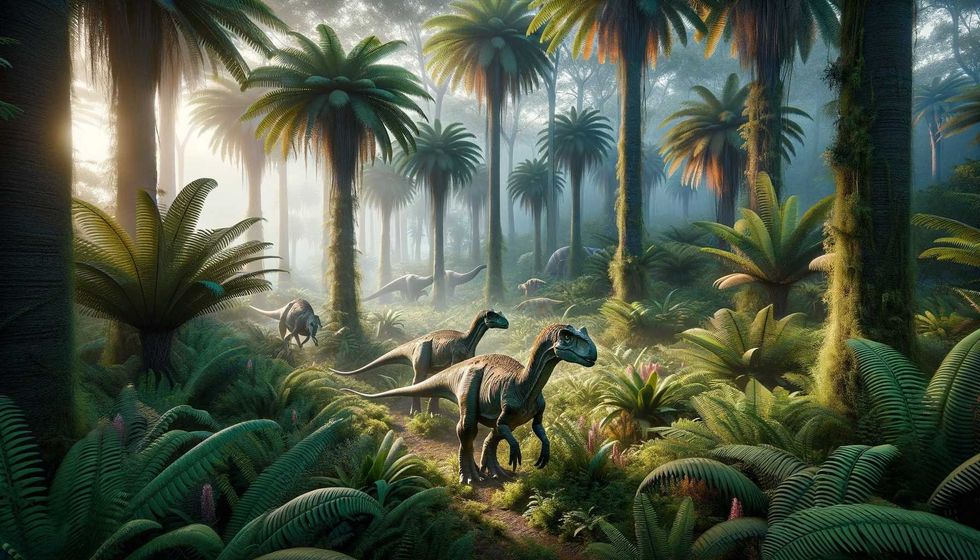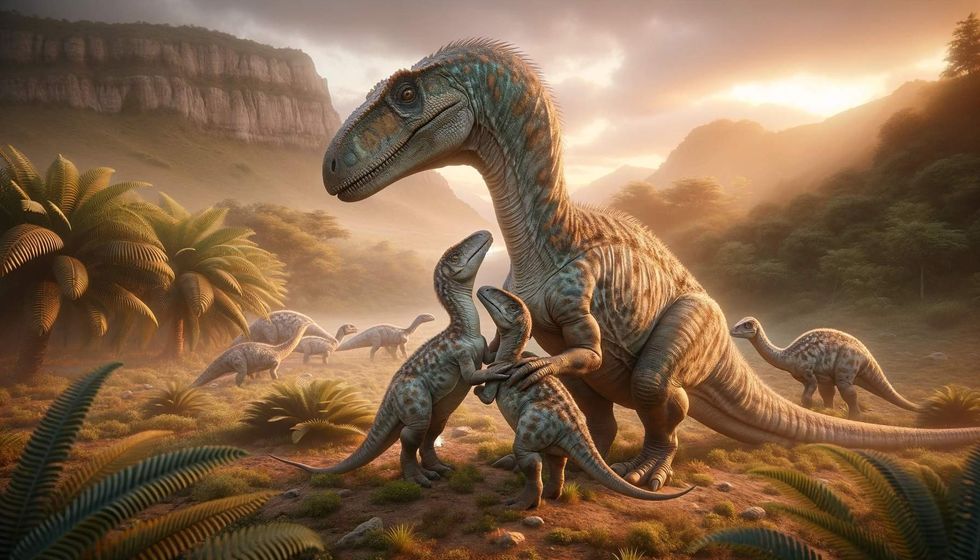The Mamenchisaurus dinosaur is one of the Jurassic Period's most amazing creatures. With its incredibly long neck, this dinosaur family captures your imagination and makes you wonder about the prehistoric world.
Scientists have learned about Mamenchisaurus through incredible fossil discoveries, including one at a construction site! Fossils found in different places tell us that these dinosaurs lived in all sorts of environments, from forests to open plains. They used their long necks to reach the tastiest leaves high in the trees.
The Mamenchisaurus is more than just a dinosaur, it's a reminder of how incredible nature can be. There's still so much to learn about these creatures, and there's no better chance than this exploratory journey to find out!
Mamenchisaurus Interesting Facts

How do you pronounce 'Mamenchisaurus'?
This Jurassic dinosaur's name is pronounced 'Mah-MEN-chee-SAWR-us'.
What type of dinosaur was it?
Imagine a dinosaur with a neck so long it could reach the leaves of the tallest trees! That was the Mamenchisaurus, a fascinating giant from the past. It belonged to a family of sauropods.
In which geological period did this dinosaur roam the Earth?
This amazing creature lived during the Late Jurassic Period, about 63.5-157.3 million years ago. The specific time it roamed the Earth is known as the Oxfordian Stage..
When did the Mamenchisaurus become extinct?
This dinosaur species disappeared in the Late Jurassic Period, around 150 million years ago).
Where did this dinosaur live?
The first Mamenchisaurus fossils were an exciting discovery! They were found in 1952 while workers were building the Yitang Highway in China's Sichuan Province. Since then, more of these incredible dinosaur fossils have popped up in other parts of China and even across Asia.
What was their habitat?

Mamenchisaurus probably lived in areas with thick forests and wide, open floodplains.
Who did they live with?
The discovery of four individual members of their species together suggests that these dinosaurs lived in groups.
How long did this dinosaur live?
While dinosaurs like Mamenchisaurus are fascinating to study, no one knows exactly how long they lived. Scientists haven't found enough clues to know for sure. But maybe one day, they'll discover something new that helps humans understand how long these amazing creatures roamed the Earth.
How did they reproduce?
Like most dinosaurs, Mamenchisauruses probably laid eggs to have their babies.
Mamenchisaurus Fun Facts
What did they look like?

Imagine a dinosaur with a neck so long it could look into a second-story window! That's what the Mamenchisaurus was like. This amazing creature was among the largest sauropods. It had one of the longest necks of any dinosaur, easily reaching high into the trees for food.
How many bones did a Mamenchisaurus have?
It's been tricky for scientists to find complete dinosaur skeletons. But some dinosaurs, like Mamenchisaurus constructus, had incredibly long neck bones.
How did they communicate?
While no one has all the details, these giant dinosaurs likely communicated in ways humans can understand. They probably used body language, just like animals do today.
They also might have made loud calls, possibly using their long necks like giant megaphones!
How big was the Mamenchisaurus?
These animals were absolutely enormous! Depending on the exact type, an adult Mamenchisaurus could grow anywhere from 43-85 ft (13-26 m) long. That's bigger than a school bus!
How fast could this dinosaur move?
This is just like a puzzle where you don't have all the pieces! Scientists don't have complete dinosaur skeletons for every species to fully understand how quickly they moved.
Some, like Mamenchisaurus constructus, are especially tricky because they had unusual features like super-long neck bones. More discoveries could help get a clearer picture of how these amazing creatures were built.
How much did a Mamenchisaurus weigh?
While their exact weight depended on the species, these dinosaurs were incredibly heavy! Their weight could range from about the size of a large truck, about 11,023 lbs (5,000 kg), to a weight multiple times heavier, up to 55,116 lbs (25,000 kg).
What were the male and female names of the species?
There are no distinct names for male and female Mamenchisaurus.
What would you call a baby Mamenchisaurus?
A baby Mamenchisaurus can be called a juvenile.
How aggressive were they?
Not much is known about how Mamenchisaurus dinosaurs acted, especially if they were aggressive or not. Scientists are still trying to figure that out!
Did you know...
The story of Mamenchisaurus begins in 1952. Workers building a highway in China's Sichuan Province stumbled upon some unusual fossils. These belonged to a dinosaur from the Late Jurassic Period, a time long, long ago!
In 1954, a famous Chinese scientist, Professor CC Young, carefully studied the bones and officially named the dinosaur Mamenchisaurus constructus.
In 1972, scientists Young and Xijin Zhao made a remarkable discovery: a new type of Mamenchisaurus dinosaur! They named it Mamenchisaurus hochuanensis after the village near Hechuan, China (part of the Sichuan Province) where its fossils were found.
In 1998, scientists Yihong Zhang, Kui Li, and Qinghua Zeng discovered another fascinating new dinosaur species called Mamenchisaurus jingyanensis. They found several important fossils: pieces of a shoulder blade, a complete shoulder bone, parts of a front leg, a complete hip bone, a mostly intact skull, and even a small bone from the neck.
The dinosaur called Mamenchisaurus has a funny-sounding name, but it actually has a simple meaning: 'Mamenchi lizard'. The name comes from a mix of Chinese words for 'horse', 'gate', and 'stream' and was meant to honor the place where the fossils were found. They added 'saurus' at the end, which is a fancy word for 'lizard'.
There's some interesting discussion about whether all the dinosaurs called "Mamenchisaurus" really belong in the same group. Some of these dinosaurs are super well-known, but others only have a few bits and pieces of their fossils to study.
Mamenchisaurids come in different sizes and have some unique features, but they all share the classic sauropod look: four legs, a big body, a tiny head, and a super-long tail.
Mamenchisaurus were herbivorous dinosaur species, and scientists think they might have had a special trick for getting bigger and stronger. They may have looked for lysine-rich plants, a building block their body needs to grow.
Fans of 'The Lost World: Jurassic Park' might remember seeing Mamenchisaurus in the video game! These were those dinosaurs with the super long necks.
FAQs
Is Mamenchisaurus the biggest dinosaur?
Mamenchisaurus dinosaurs are famous for their super long necks, but they weren't the biggest dinosaurs ever! They were part of a group called sauropods that lived in China a long, long time ago.
One kind of Mamenchisaurus, called Mamenchisaurus sinocanadorum, had an especially amazing neck. Scientists think it might have been about 49 ft (15 m) long; that's longer than a school bus!
What dinosaurs lived with them?

Mamenchisaurus existed a really long time ago, about 150-160 million years! They roamed around what is now Asia, especially in China and Mongolia. Mamenchisaurus shared its home with other dinosaurs, but scientists haven't figured out exactly which ones yet. Hopefully, with more discoveries, humans will learn all about the other amazing creatures that lived alongside Mamenchisaurus.
Why do they have long necks?
Giant dinosaurs like Mamenchisaurus had those amazing long necks for a few reasons. They could stay in one spot and munch on tons of plants without moving much, saving them energy. Their necks might have also helped them cool down, kind of like how elephants use their big ears.
You won't see any animals today with necks like that! Scientists like Dr. Moore from Stony Brook University used special scans to discover that Mamenchisaurus bones were filled with air pockets. This made their super-long necks surprisingly light!
The Mamenchisaurus, with its title as one of the dinosaurs with the longest neck, is a powerful symbol of the amazing creatures that roamed the Earth long ago. These gentle giants were some of the largest dinosaurs ever, and their story is a fascinating one.
The name Mamenchisaurus tells us about the history of discovery and the exciting discoveries of paleontologists. They study fossils to piece together the story of these dinosaurs, giving you a glimpse into a world almost too amazing to imagine.
Related Articles Around the Web













